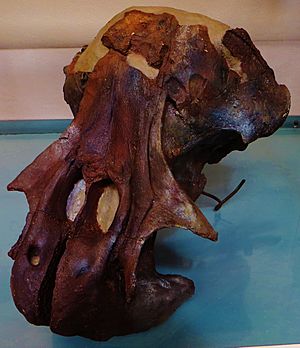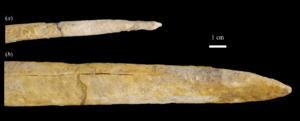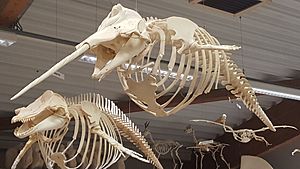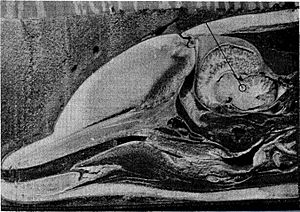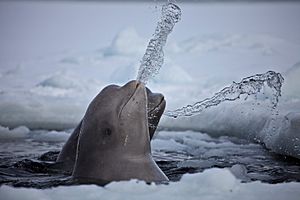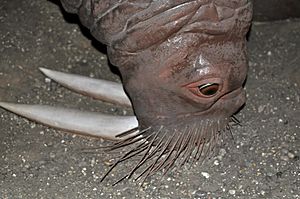Odobenocetops facts for kids
Quick facts for kids Odobenocetops |
|
|---|---|
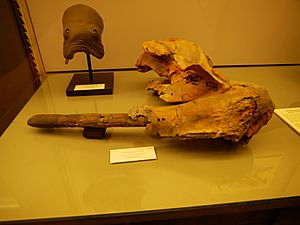 |
|
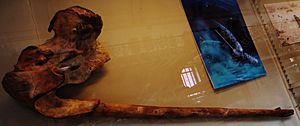 |
|
| Odobenocetops peruvianus (top) and Odobenocetops leptodon (bottom) | |
| Scientific classification |
|
| Kingdom: | Animalia |
| Phylum: | Chordata |
| Class: | Mammalia |
| Order: | Artiodactyla |
| Infraorder: | Cetacea |
| Superfamily: | Delphinoidea |
| Family: | †Odobenocetopsidae Muizon, 1993 |
| Genus: | †Odobenocetops Muizon, 1993 |
| Type species | |
| †Odobenocetops peruvianus Muizon, 1993
|
|
| Species | |
|
|
Odobenocetops was an amazing extinct (meaning it no longer exists) toothed whale that lived a long time ago. Its name means "whale that seems to walk on its teeth," which is a fun way to describe its unique look!
This ancient whale lived during the Miocene epoch, about 5 to 23 million years ago. Its fossils have been found in countries like Chile and Peru in South America. Scientists have identified two main types, or species, of Odobenocetops: O. peruvianus and the slightly younger O. leptodon.
Odobenocetops is famous for its two very long, uneven tusks. These tusks grew from its upper jaw. The longer tusk could reach up to 1.35 metres (4 ft 5 in) (about 4.4 feet) long! Even though they look like the tusk of a narwhal, they actually grew in a different way. Scientists think these tusks were mostly found in male Odobenocetops, like how male narwhals have a long tusk. Female Odobenocetops likely had two shorter tusks that were about the same size.
Scientists are still not sure what the tusks were used for. They were probably too thin and delicate for fighting or digging. A popular idea is that they were used for social reasons, maybe to show who was in charge without actually fighting. Besides these two tusks, Odobenocetops didn't have any other teeth.
Contents
Discovering Odobenocetops
How we found this ancient whale
The first fossil of Odobenocetops was a skull found in Peru in 1990. It was missing part of its left side. This skull helped scientists learn about this amazing creature.
In 1993, a scientist named Christian de Muizon studied this skull. He gave it the name Odobenocetops and called this first species O. peruvianus. Because this whale was so unusual, he also created a new family group for it, called Odobenocetopsidae.
More fossils and new species
Later, more fossils were found, including three more skulls. One of these was thought to be a female O. peruvianus. The other two skulls were different enough to be named a new, younger species: O. leptodon.
The best O. leptodon fossil is a nearly complete skull. Another O. leptodon skull was found, but it was not as complete. These new finds helped scientists learn even more about Odobenocetops.
What the name means
The name Odobenocetops comes from Greek and Latin words.
- Odon means "tooth."
- Baino means "walk."
- Cetus means "whale."
- Ops means "like."
So, the full name means "cetacean that seems to walk on its teeth." This name was chosen because of its unique tusks and how it might have fed. It also refers to its similarity to the walrus (whose scientific name is Odobenus). The species name peruvianus simply means "from Peru," where it was first found.
What Odobenocetops Looked Like
The skull of Odobenocetops was very different from any modern whale. It had a unique shape, looking like an hourglass from above. The front part of its head, where the tusks and nostrils were, was separated from the back by a narrow section.
Modern whales have skulls that are "telescoped," meaning some bones are very close together. But Odobenocetops' skull seemed to reverse this. Its maxilla and frontal bones moved towards the snout, and its nostrils (where it breathed) moved to the front of its head. This made its snout short and round, unlike the long snouts of other whales.
Eyes and other features
The eyes of Odobenocetops faced upwards and sideways. This might have given it binocular vision, meaning it could see depth well, like humans do. Its mouth had a deep, arched roof, similar to a walrus. Besides the two tusks, it had no other teeth.
The tip of its snout had many places for strong facial muscles. This suggests it had a very powerful upper lip. It might have even had sensitive hairs, called vibrissae, like a walrus uses to feel around.
Differences between the species
The two species, O. peruvianus and O. leptodon, had some differences:
- O. peruvianus likely had a very small melon (an organ for echolocation) or none at all. It probably relied more on its excellent vision.
- O. leptodon had a deeper and wider mouth roof. It also had small depressions on its snout, suggesting it had a small melon. This means O. leptodon might have used echolocation more, while its binocular vision might not have been as good as O. peruvianus.
- O. leptodon also had a unique pair of extra bones at the tip of its snout. These bones are seen in animals like elephant shrews and moles, which have strong upper lips.
The skull of O. peruvianus was about 46 cm (18 in) long. Scientists think Odobenocetops' body length was about 3–4 metres (9.8–13.1 ft) (10-13 feet). It might have weighed between 800–1,000 kg (1,800–2,200 lb) (1,760-2,200 pounds), similar to a modern narwhal.
Amazing tusks
The tusks of Odobenocetops were made entirely of dentine. They grew from large bony parts of the upper jaw, pointing backwards and downwards.
- In O. peruvianus, the right tusk was longer, estimated to be 45–55 cm (18–22 in) (1.5-1.8 feet). The left tusk was much smaller, perhaps only 20 cm (7.9 in) (8 inches).
- In O. leptodon, the right tusk was very long, about 1.35 metres (4 ft 5 in) (4.4 feet). The left tusk was much shorter, about 25 cm (9.8 in) (10 inches).
These tusks were quite fragile. This suggests they weren't used for forceful actions like fighting or digging. Scientists think they might have been used for social displays. For example, the long tusk of O. leptodon showed wear at its tip, suggesting it might have been dragged along the seafloor. This could have helped the animal find its way while looking for food.
How Odobenocetops Lived
Super senses
As mentioned, Odobenocetops had a very special skull shape. This meant its melon, an organ important for echolocation (using sound to "see"), was either very small or completely missing.
However, its inner ear was well-developed for hearing high-frequency sounds, like those used in echolocation. It could probably hear sounds between 35 to 50 kHz. But without a proper melon, it likely couldn't send out strong sound signals itself. It might have just listened to sounds in its environment.
To make up for this, O. peruvianus had large eyes that faced upwards. This gave it excellent binocular vision, helping it see well in the water. O. leptodon might not have had such good binocular vision, but it did have a small melon, suggesting it used some form of echolocation.
Scientists also think Odobenocetops might have had sensitive vibrissae (whiskers or tactile hairs) on its snout, similar to a walrus. These hairs would have helped it feel around for food on the seafloor.
Amazing neck movement
Odobenocetops had an incredibly flexible neck. It could move its head more than any other whale, even more than the beluga whale! This was very helpful for finding food.
When swimming, it could angle its head downwards to keep its long tusk parallel to its body, reducing drag. When feeding, it could bend its neck far back, pointing its head and tusks towards the seafloor. This allowed it to search for food on the bottom of the ocean.
How it found food
Odobenocetops likely fed very much like a modern walrus. It was a molluscivore, meaning it ate molluscs like bivalves (clams and mussels).
Here's how scientists think it fed:
- It would swim along the seafloor, using its vision or echolocation (depending on the species) and possibly its sensitive whiskers to find buried shellfish.
- Once it found prey, it might have used its mouth to create a powerful jet of water. This would blast away the sand or mud, uncovering the shellfish.
- Then, it would use its strong upper lip to grab the mollusc.
- Finally, it would use its tongue like a piston to suck out the soft parts of the mollusc, leaving the shell behind. Its mouth worked like a powerful vacuum cleaner!
This way of eating is called "suction feeding." The strong muscles in its jaw and throat helped it create this powerful suction. Both species of Odobenocetops were likely bottom-feeders, just like the walrus.
Where Odobenocetops Lived
Odobenocetops fossils are mostly found in the Pisco Formation in Peru. This area was once a calm, shallow coastal environment. Many other amazing marine animals lived there too, including:
- Different types of whales, like rorquals and giant sperm whales such as Livyatan.
- The marine sloth Thalassocnus.
- The giant shark Megalodon.
- Two types of marine gharials (a type of crocodile).
- Various seals and penguins.
The area also had many bivalves like clams and mussels, which were probably the main food source for Odobenocetops.
Fossils of Odobenocetops have also been found in the Bahía Inglesa Formation in Chile. This area was once a flat beach or berm zone. Other animals found there include seals, whales, billfish, and sharks.
Images for kids
See also
 In Spanish: Odobenocetops para niños
In Spanish: Odobenocetops para niños


